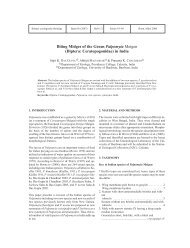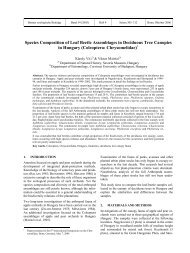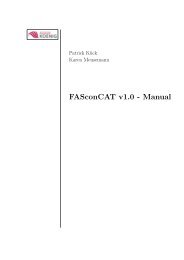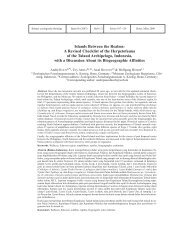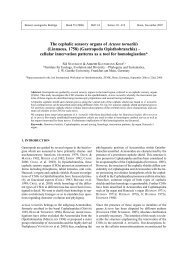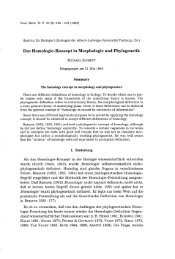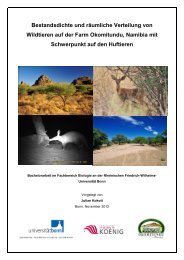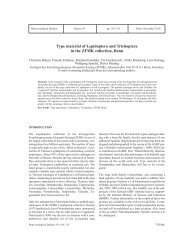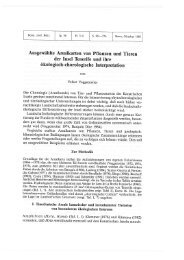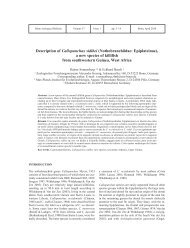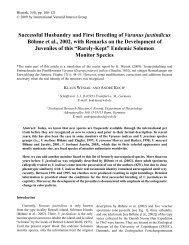Biogeography of the Sacoglossa (Mollusca, Opisthobranchia)*
Biogeography of the Sacoglossa (Mollusca, Opisthobranchia)*
Biogeography of the Sacoglossa (Mollusca, Opisthobranchia)*
You also want an ePaper? Increase the reach of your titles
YUMPU automatically turns print PDFs into web optimized ePapers that Google loves.
262 Ka<strong>the</strong> R. JENSEN: <strong>Biogeography</strong> <strong>of</strong> <strong>Sacoglossa</strong><br />
Table 5. Similarity <strong>of</strong> Japanese biogeographic provinces and <strong>of</strong> Northwest and Nor<strong>the</strong>ast Pacific provinces. The Japanese provinces<br />
have also been compared to <strong>the</strong> neighboring Central Pacific sub-province. Abbreviations: see Table 3.<br />
a.<br />
CJ \ SD Japan cold Japan warm Ryukyu Central Pacif. NW Pacif. cold NE Pacif.<br />
temp., N=26 temp., N=41 N=33 N=51 temp., N=29 cold temp.<br />
N=10<br />
Japanese cold temp. - 59.7 27.1 26.0 - n.d.<br />
Japanese warm temp. 42.6 - 37.8 37.0 n.d. n.d.<br />
Ryukyu 15.7 23.3 - 38.1 n.d. n.d.<br />
Central Pacific 14.9 22.7 23.5 - n.d. n.d.<br />
NW Pacific cold temp. - n.d. n.d. n.d. - 20.5<br />
NE Pacific cold temp. n.d. n.d. n.d. n.d. 11.4 -<br />
b.<br />
I Japan cold Japan warm Ryukyu NW Pacif.<br />
temp. temp. cold temp.<br />
Japanese cold temp. - - - -<br />
Japanese warm temp. 76.9 - - -<br />
Ryukyu 30.8 42.4 - -<br />
Central Pacific 38.5 41.5 48.5 -<br />
NE Pacific cold temp - n.d. n.d. 40.0<br />
Four biogeographic regions or provinces can be distinguished<br />
along <strong>the</strong> coasts <strong>of</strong> Japan. Biogeographically <strong>the</strong><br />
sou<strong>the</strong>rnmost archipelago <strong>of</strong> Ryukyu belongs in <strong>the</strong> vast<br />
tropical Indo-Polynesian province (BR I G G S 1995), but being<br />
under Japanese jurisdiction, <strong>the</strong> sacoglossan fauna has<br />
been studied mostly by Japanese scientists (e.g. BABA<br />
1936; HAMATANI 1980; ICHIKAWA 1993). Hence Ryukyu<br />
has been included in both analyses <strong>of</strong> <strong>the</strong> Japanese fauna<br />
(Table 5) and <strong>of</strong> <strong>the</strong> Indo-West Pacific one (Table 7). The<br />
warm-water temperate region comprises sou<strong>the</strong>rn and<br />
eastern Japan, including <strong>the</strong> well studied Seto Inland Sea<br />
and Sagami Bay. The corresponding continental coast <strong>of</strong><br />
China has been insufficiently studied, and only 14<br />
species have been recorded from sou<strong>the</strong>rn Korea (KOH<br />
2002a,b, 2003, 2005a,b,c; RU D M A N, S y d n e y, pers. comm.<br />
2007). The cold-water temperate oriental province includes<br />
<strong>the</strong> central and western coasts <strong>of</strong> Honshu, whereas<br />
<strong>the</strong> nor<strong>the</strong>rnmost island <strong>of</strong> Hokkaido belongs to <strong>the</strong><br />
Kurile province (BRIGGS 1995). The cold-temperate fauna<br />
<strong>of</strong> Japan contains more species (N=26) than any o<strong>the</strong>r<br />
cold-water fauna. A few shelled species extend into this<br />
province, which is also seen in sou<strong>the</strong>rn Australia, but not<br />
in o<strong>the</strong>r cold-water provinces. Only three additional<br />
sacoglossan species have been recorded from <strong>the</strong> Kurile<br />
province (BABA 1935; CHERNYSHEV & CHABAN 2005;<br />
TROWBRIDGE 2006) and <strong>the</strong>se were only included in <strong>the</strong><br />
comparison <strong>of</strong> Nor<strong>the</strong>ast and Northwest Pacific cold-water<br />
faunas (Table 5). The highest number <strong>of</strong> species has<br />
been recorded from <strong>the</strong> warm temperate region (e.g. BA-<br />
B A 1949, 1952a,b, 1955, 1957, 1959, 1966; 1968;<br />
HAMATANI 1968, 1969, 1972, 1976a,b, 1994; KAWAGUTI<br />
& BA B A 1959; HI R A N O et al. 2006); in fact BA B A d e s c r i b e d<br />
59% <strong>of</strong> <strong>the</strong> species from this province and 69% <strong>of</strong> <strong>the</strong><br />
species from <strong>the</strong> cold-water region <strong>of</strong> Japan. A few <strong>of</strong> <strong>the</strong><br />
species described by BABA have been synonymized with<br />
more widespread Indo-West Pacific species (BABA 1974;<br />
JE N S E N 1985). On <strong>the</strong> o<strong>the</strong>r hand, many <strong>of</strong> BA B A’s species<br />
have been identified outside Japan (JENSEN 1985; CARL-<br />
SON & HOFF 1978, 2003; BURN 1998, 2006).<br />
The Nor<strong>the</strong>ast Australian and Great Barrier Reef faunas<br />
(BURN 1966b; THOMPSON 1973; MARSHALL & WILLAN<br />
1999; WÄGELE & JOHNSON 2001) are so closely related to<br />
each o<strong>the</strong>r that no endemics have been recorded from <strong>the</strong><br />
Great Barrier Reef and only one endemic species, Placi -<br />
da fralila, has been recorded from Nor<strong>the</strong>ast Australia<br />
(Table 2). Hence <strong>the</strong>se two provinces were merged for<br />
similarity analyses, and <strong>the</strong> combined province has two<br />
endemic species (Elysia bennettae, P. fralila). For <strong>the</strong><br />
Great Barrier Reef 30% <strong>of</strong> <strong>the</strong> species were listed as<br />
unidentified and/or undescribed (MARSHALL & WILLAN<br />
1999). This part <strong>of</strong> Australia has been included in <strong>the</strong> Indo-Polynesian<br />
province by BR I G G S (1995). This is supported<br />
by <strong>the</strong> low endemicity, and also, <strong>the</strong> similarity with <strong>the</strong><br />
fauna <strong>of</strong> <strong>the</strong> South Pacific islands is higher than with any<br />
<strong>of</strong> <strong>the</strong> o<strong>the</strong>r Australian provinces (Tables 6 and 7). The<br />
North and Northwestern Australian fauna has ra<strong>the</strong>r high<br />
similarity to <strong>the</strong> Western Indian Ocean fauna (Table 7).<br />
This is in spite <strong>of</strong> <strong>the</strong> fact that almost 40% <strong>of</strong> <strong>the</strong> species<br />
have been described by <strong>the</strong> present author within <strong>the</strong> last<br />
20 years (JE N S E N 1993b, 1997b,c; JE N S E N & WE L L S 1 9 9 0 ) .<br />
The fauna <strong>of</strong> <strong>the</strong> South and Southwestern Australia has




